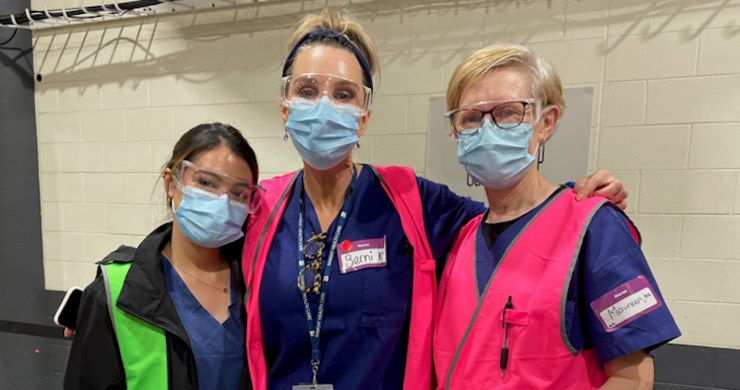Australia's health workforce shortage is impacting patient care and the wellbeing of staff on the frontlines.
Ramsay Health Care Chief Nurse and Clinical Services Director, Dr Bernadette Eather, said the past few years had been a challenging time for healthcare workers, and 2022 had brought additional issues.
"We're seeing the continued impacts of COVID-19 and seasonal flu – in June and July we've had the highest level of sick leave since the start of the pandemic," she said.
"This third wave of Omicron has really impacted a lot of people.
"We've got casuals and part-timers unable take on more shifts, or they don't want to because they're just exhausted.
"Hospitals are dealing with high staff turnover, staff doing double shifts and we currently don't have the flexibility that we would like.
"Our purpose as nurses is to provide high quality care for our patients, and we're finding that very challenging right now."
In fact, the private hospital sector is short about 8000 nurses and looking to changes in Australia's skilled migration system to alleviate the immediate pain.
Australian Private Hospitals Association CEO Michael Roff said Australia is being left behind in the global race to fill health workforce vacancies.
"Australia needs to act now on this issue. We are already being overtaken by countries who are prepared to go the extra mile to attract workers."
Mr Roff said examples of incentives offered by other countries included reducing costs to employers, making health and care workers priority workers and fast-tracking visa applications.
"According to the UK Nursing and Midwifery Council, these measures saw the international health workforce in the UK increase by 23,000 in the 12 months to March 2022 – breaking records in international recruitment," he said.
"Australia is experiencing a chronic shortage of nurses.
"The private hospital sector is feeling the pinch. In 2020 our hospitals were worried they wouldn't have enough PPE (personal protective equipment) for their nurses, now they are worried they won't have enough nurses for the PPE."
Mr Roff said the Federal Government had to step in to offer prospective nurses and health workers the option of a future in Australia, while also building a home-grown workforce for the future.
But building the workforce needed to be a national program, not various states and territories going off on their own leading to a bidding war, he said.
The Victorian Government has recently pledged to pay nursing students starting study in 2023 and 2024 a total of $16,500. Students will receive $9,000 during study and the rest of the sum if they commit to working in the public hospital sector for two years. It also announced a range of scholarships for nurses to upskill, but only for public sector workers.
Mr Roff dismissed the plan as 'a poorly though-out piece of electioneering' that could force service closures in the private sector.
"The Victorian Premier's plan will also undermine the Federal Government's plan to attract more nurses into aged care. If they are training only to go into public hospitals, there are no nurses for the Federally managed aged care sector.
"All this does is start a bidding war between states and territories and across the health system for a workforce that isn't there.
"We agree with Federal Health Minister Mark Butler that Australia needs a national strategy to address the health workforce shortage. If each state and territory follows Victoria's lead, we will not have a national strategy but eight different approaches competing with each other," he said.
Dr Eather said the move would have a negative impact on private hospitals in Victoria.
"I mean, that support for undergraduate nurses is fantastic and it should be there for teachers and all kinds of professions, but it should be for all nurses, not just the public system. There was no consultation, which was disappointing."
Dr Eather said Ramsay offered a range of career pathways for graduate nurses, including a cadet program, and graduate fellowships.
"It's never been more important to motivate our workforce, and to let people know just how fabulous this career is," she said.
"Our nurse unit managers are the glue holding it all together right now – they know the pressure points for our nurses, and they know who is at risk of leaving.
"For example, we don't want nurses doing a lot of non-nursing work – so we need to look at ways to take away admin and paperwork.
"There's a huge opportunity right now at a government level to focus on pathways for nurse practitioners – there's a huge shortage of GPs, particularly in regional areas, so developing ways for nurse practitioners to work in those communities is something we should be looking at."
Dr Eather said she hoped to see a collaborative approach to the healthcare worker shortage.
"It's been a tough few years, but healthcare is where it's at," she said.
"We're conscious of the challenges, we recognise that our staff are under pressure.
"But nurses are very good at adapting, and it means there's exciting opportunities up ahead.
"We need to co-ordinate the response to this at a national level, rather than each state just acting independently.
"I'm confident that if we collaborate and co-ordinate a national strategy – which is what we did during the pandemic – with all of us taking a collegiate approach, we can develop the Australian nursing workforce."
Next On The Ground:
12/9/2022 'Way of the future' transforms patient outcomes
Previous On The Ground:
31/8/2022 'Champion' nurse empowers vulnerable patients
![[APHA]](/images/logo_apha.svg)
